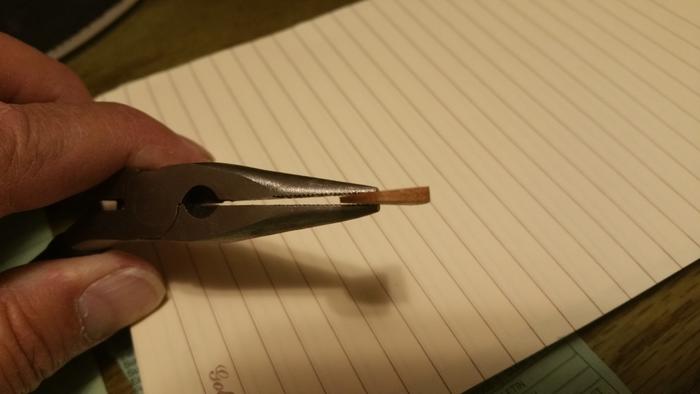Results 1 to 6 of 6
 9Likes
9Likes
Thread: Made New Scales, Mentors/Experienced Coaching Desired
-
04-15-2017, 02:24 AM #1
 Made New Scales, Mentors/Experienced Coaching Desired
Made New Scales, Mentors/Experienced Coaching Desired
The first pic below are the first scales I made. Feedback was both encouraging and helpful. With this new set I tried to:
- make the scales thinner
- Make a lead wedge
- Round the edges as shown in the lesson on making scales
- Make the interior side of the scales polished enough so water will run off
- Put the pins in the right place
If I had this project to do again, I would probably do less rounding as that takes away from the horn bark to me.
Input would be greatly appreciated. The coaching last time was awesome.






Last edited by Pete123; 04-15-2017 at 02:29 AM. Reason: Forgot a pic
-
04-15-2017, 04:02 PM #2

Much better this time Pete. The only thing that come to me is next time try to make a smoother curve to the scale. Looks like its got a bend in the middle enstead of a even sweep to the curve. And the wedge looks more like a spacer than a wedge. I had a hard time figuring out wedges. The things are just so thin on one end its hard to do without a tool. The sanding that is. Overall i think your getting much better. It takes a few trys before it all comes together.
It's just Sharpening, right?
Jerry...
-
The Following User Says Thank You to Gasman For This Useful Post:
Pete123 (04-15-2017)
-
04-15-2017, 05:26 PM #3

Here are some solutions to making cleaner curves and arcs used on scales:http://straightrazorpalace.com/works...ml#post1691774
Keep up the god work!
~RichardBe yourself; everyone else is already taken.
- Oscar Wilde
-
The Following User Says Thank You to Geezer For This Useful Post:
Pete123 (04-15-2017)
-
04-15-2017, 06:09 PM #4Senior Member



- Join Date
- Apr 2012
- Location
- Diamond Bar, CA
- Posts
- 6,553
Thanked: 3215
Yes, a true, tapered wedge will work much better than a spacer, especially with horn, keeps tension on the pin and a slight bow in the scales preventing some warping. It does not need to be thick, 1/16 is plenty.
When thinning your scales, use a pair of calipers to measure the thickness and ensure they are the same thickness before shaping. An inexpensive pair of calipers will help a lot. You can buy a decent pair of plastic (General) Calipers for a few dollars, that are good enough, for this level of precision.
I shoot for a uniform thickness of just under 1/8 in .110 - .95, then shape being careful to not remove too much from the top.
It is personal preference but, I shape horn scales from a center line and taper out to the sides, in a gentile curve, ending at the flat inside of the scale, that is easy on the hand, no flats. You will end up with a very thin, flat on the edge of the scales, about a 32nd that will blend to a curve at final sanding.
Here, scraping after sanding the angles pays large dividends and give you a smooth curve without much finish sanding. You can make good scrapers from old steak knives, putty knives (thin spring steel from the dollar store) or single edge razor blades, use a plastic holder for comfort. You cannot beat the speed and finish from scraping.
Do not cut to the final line, cut proud of the line and sand to the line, so you get a uniform, smooth shape.
If you are hand sanding to shape, glue some 80 grit to pieces of PVC and wooden paint stir sticks to give you more uniform shaping. Horn sands and shapes easily.
Pin your wedge 3/8 -1/2 in from the end of the scale, depending on the length of the wedge, I shoot for 9/16 in wedge. Also doming your collars slightly and polishing will make them look much more finished. A metal doming block or home made one from wood dimpled with a ball peen hammer and rounded chopstick will work surprisingly well.
Once installed, polish with a cut off chopstick in a drill press, with metal polish. It will also smooth out your pins.
Use an old pair of scales as a template, for size, shape and pin hole locations, there are tracing on line if you do not have original scales.
Review Karl’s post on making Horn Scales, a couple of times, there is a lot of good information in that post.
-
-
04-15-2017, 06:27 PM #5

Thank you for the great input!
-
04-16-2017, 09:14 AM #6

Here is a pic of a wedge i recently made. Havent installed it yet. Thought it might help you to see the difference in thickness. The thickest part is .100 and the thinnest part is .042 made of wood. I find lead is easier as i just smash it with a hammer close to the thicknesses i want, then clip it to a close enough shape with side cutters then sand a bit and its done. Wood takes a lot more sanding and work to get what you want.

So with the wedge held in place between the scales with your fingers, the spread at the pivot end of the scales is about an inch. This gives you the bow in the scales that helps it all to work.
Hope this helps.Last edited by Gasman; 04-16-2017 at 09:16 AM.
It's just Sharpening, right?
Jerry...
-



 LinkBack URL
LinkBack URL About LinkBacks
About LinkBacks






 Reply With Quote
Reply With Quote
